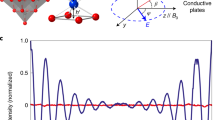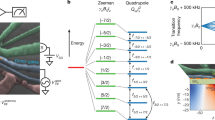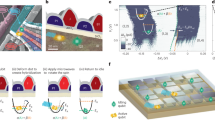Abstract
Quantum computing is an emerging area within the information sciences revolving around the concept of quantum bits (qubits). A major obstacle is the extreme fragility of these qubits due to interactions with their environment that destroy their quantumness. This phenomenon, known as decoherence, is of fundamental interest1,2. There are many competing candidates for qubits, including superconducting circuits3, quantum optical cavities4, ultracold atoms5 and spin qubits6,7,8, and each has its strengths and weaknesses. When dealing with spin qubits, the strongest source of decoherence is the magnetic dipolar interaction9. To minimize it, spins are typically diluted in a diamagnetic matrix. For example, this dilution can be taken to the extreme of a single phosphorus atom in silicon6, whereas in molecular matrices a typical ratio is one magnetic molecule per 10,000 matrix molecules10. However, there is a fundamental contradiction between reducing decoherence by dilution and allowing quantum operations via the interaction between spin qubits. To resolve this contradiction, the design and engineering of quantum hardware can benefit from a ‘bottom-up’ approach whereby the electronic structure of magnetic molecules is chemically tailored to give the desired physical behaviour. Here we present a way of enhancing coherence in solid-state molecular spin qubits without resorting to extreme dilution. It is based on the design of molecular structures with crystal field ground states possessing large tunnelling gaps that give rise to optimal operating points, or atomic clock transitions, at which the quantum spin dynamics become protected against dipolar decoherence. This approach is illustrated with a holmium molecular nanomagnet in which long coherence times (up to 8.4 microseconds at 5 kelvin) are obtained at unusually high concentrations. This finding opens new avenues for quantum computing based on molecular spin qubits.
This is a preview of subscription content, access via your institution
Access options
Subscribe to this journal
Receive 51 print issues and online access
$199.00 per year
only $3.90 per issue
Buy this article
- Purchase on Springer Link
- Instant access to full article PDF
Prices may be subject to local taxes which are calculated during checkout




Similar content being viewed by others
References
Schlosshauer, M. A. Decoherence and the Quantum-To-Classical Transition (Springer, 2008)
Stamp, P. C. E. Quantum information: stopping the rot. Nature 453, 167–168 (2008)
Devoret, M. H. & Schoelkopf, R. J. Superconducting circuits for quantum information: an outlook. Science 339, 1169–1174 (2013)
Duan, L. Quantum physics: a strong hybrid couple. Nature 508, 195–196 (2014)
Weitenberg, C. et al. Single-spin addressing in an atomic Mott insulator. Nature 471, 319–324 (2011)
Pla, J. J. et al. A single-atom electron spin qubit in silicon. Nature 489, 541–545 (2012)
Taminiau, T. H., Cramer, J., van der Sar, T., Dobrovitski, V. V. & Hanson, R. Universal control and error correction in multi-qubit spin registers in diamond. Nature Nanotechnol . 9, 171–176 (2014)
Ardavan, A. et al. Will spin-relaxation times in molecular magnets permit quantum information processing? Phys. Rev. Lett. 98, 057201 (2007)
Takahashi, S. et al. Decoherence in crystals of quantum molecular magnets. Nature 476, 76–79 (2011)
Kaminski, D. et al. Quantum spin coherence in halogen-modified Cr7Ni molecular nanomagnets. Phys. Rev. B 90, 184419 (2014)
Wedge, C. J. et al. Chemical engineering of molecular qubits. Phys. Rev. Lett. 108, 107204 (2012)
Leuenberger, M. N. & Loss, D. Quantum computing in molecular magnets. Nature 410, 789–793 (2001)
Warner, M. et al. Potential for spin-based information processing in a thin-film molecular semiconductor. Nature 503, 504–508 (2013)
Graham, M. et al. Influence of electronic spin and spin-orbit coupling on decoherence in mononuclear transition metal complexes. J. Am. Chem. Soc. 136, 7623–7626 (2014)
Thiele, S. et al. Electrically driven nuclear spin resonance in single-molecule magnets. Science 344, 1135–1138 (2014)
Bader, K. et al. Room temperature quantum coherence in a potential molecular qubit. Nature Commun. 5, 5304 (2014)
Clemente-Juan, J. M. & Coronado, E. Magnetic clusters from polyoxometalate complexes. Coord. Chem. Rev. 193–195, 361–394 (1999)
Clemente-Juan, J. M., Coronado, E. & Gaita-Ariño, A. Magnetic polyoxometalates: from molecular magnetism to molecular spintronics and quantum computing. Chem. Soc. Rev. 41, 7464–7478 (2012)
Lehmann, L., Gaita-Ariño, A., Coronado, E. & Loss, D. Spin qubits with electrically gated polyoxometalate molecules. Nature Nanotechnol. 2, 312–317 (2007)
van Hoogdalem, K., Stepanenko, D. & Loss, D. in Molecular Magnets: Physics and Applications (eds Bartolomé, J. et al.) 275–296 (Springer, 2014)
AlDamen, M. A., Clemente-Juan, J. M., Coronado, E., Martí-Gastaldo, C. & Gaita-Ariño, A. Mononuclear lanthanide single-molecule magnets based on polyoxometalates. J. Am. Chem. Soc. 130, 8874–8875 (2008)
Martínez-Pérez, M. J. et al. Gd-based single-ion magnets with tunable magnetic anisotropy: molecular design of spin qubits. Phys. Rev. Lett. 108, 247213 (2012)
AlDamen, M. A. et al. Mononuclear lanthanide single molecule magnets based on the polyoxometalates [Ln(W5O18)2]9− and [Ln(β-SiW11O39)2]13− (LnIII = Tb, Dy, Ho, Er, Tm, and Yb). Inorg. Chem. 48, 3467–3479 (2009)
Ghosh, S. et al. Multi-frequency EPR studies of a mononuclear holmium single-molecule magnet based on the polyoxometalate [HoIII(W5O18)2]9−. Dalton Trans. 41, 13697–13704 (2012)
Schweiger, A. & Jeschke, G. Principles of Pulse Electron Paramagnetic Resonance (Oxford Univ. Press, 2001)
Bollinger, J. J. et al. Laser-cooled-atomic frequency standard. Phys. Rev. Lett. 54, 1000–1003 (1985)
Vion, D. et al. Manipulating the quantum state of an electrical circuit. Science 296, 886–889 (2002)
Wolfowicz, G. et al. Atomic clock transitions in silicon-based spin qubits. Nature Nanotechnol. 8, 561–564 (2013)
Balian, S. J., Wolfowicz, G., Morton, J. J. L. & Monteiro, T. S. Quantum bath-driven decoherence of mixed spin systems. Phys. Rev. B 89, 045403 (2014)
Cardona-Serra, S. et al. Lanthanoid single-ion magnets based on polyoxometalates with a 5-fold symmetry: the series [LnP5W30O110]12– (Ln3+ = Tb, Dy, Ho, Er, Tm, and Yb). J. Am. Chem. Soc. 134, 14982–14990 (2012)
Rudowicz, C. & Chung, C. Y. The generalization of the extended Stevens operators to higher ranks and spins, and a systematic review of the tables of the tensor operators and their matrix elements. J. Phys. Condens. Matter 16, 5825–5847 (2004)
Stoll, S. & Schweiger, A. EasySpin, a comprehensive software package for spectral simulation and analysis in EPR. J. Magn. Reson. 178, 42–55 (2006)
Acknowledgements
We thank L. Song and J. van Tol for technical assistance with the X-band EPR spectrometer. This work was supported by the NSF (grant DMR-1309463) and the US AFOSR (AOARD contract 134031 FA2386-13-1-4029). Work performed at the NHMFL was supported by the NSF (DMR-1157490) and by the State of Florida. Work performed at the Instituto de Ciencia Molecular was supported by the European Research Council (grants SPINMOL and DECRESIM), by the Spanish MINECO (projects MAT-2014-56143-R, CTQ2014-52758-P and Excellence Unit Maria de Maeztu MDM-2015-0538) and by the Generalidad Valenciana (Prometeo and ISIC-Nano Programs of Excellence). A.G.-A. thanks the Spanish MINECO for a Ramón y Cajal Fellowship.
Author information
Authors and Affiliations
Contributions
S.H., E.C. and A.G.-A. conceived the research and wrote the paper. Y.D. prepared the samples. S.H., M.S. and D.K. designed the experiments, while M.S. and D.K. performed the measurements. S.H., M.S. and D.K. analysed the results.
Corresponding authors
Ethics declarations
Competing interests
The authors declare no competing financial interests.
Extended data figures and tables
Extended Data Figure 1 T2 scaling.
a, b, Field-swept T2 measurements for the x = 0.001 (a) and x = 0.01 (b) concentrations at 5 K; the data are plotted as a function of (B0z − Bmin) on both log–log (main panels) and linear (insets) scales. The blue lines are power-law fits to the positive (B0z − Bmin) data (green points), with the obtained exponents (‘slope’) given in the figures. Error bars, ±standard error in T2.
Extended Data Figure 2 T2 divergence at the x = 0.01 concentration.
Shown are field-swept T2 measurements recorded at 5.0 K for two separate crystals at frequencies of 9.12 GHz (blue squares) and 9.20 GHz (red circles). Error bars, ±standard error in T2.
Extended Data Figure 3 ESE-detected spectra for the x = 0.01 concentration.
Variable frequency measurements at 5.0 K, with θ = 30°; the frequencies are indicated above each trace. Similar to spectra for the x = 0.001 sample, the broad 9.2 GHz CT peak splits into two upon moving away from the tunnelling gap minimum (see also Fig. 2). However, weak ESE intensity can still be detected at B0z = 165 mT at all four frequencies. This is due to vertical broadening of the CT, caused by a Gaussian distribution in  .
.
Rights and permissions
About this article
Cite this article
Shiddiq, M., Komijani, D., Duan, Y. et al. Enhancing coherence in molecular spin qubits via atomic clock transitions. Nature 531, 348–351 (2016). https://doi.org/10.1038/nature16984
Received:
Accepted:
Published:
Issue Date:
DOI: https://doi.org/10.1038/nature16984
This article is cited by
-
Direct determination of high-order transverse ligand field parameters via µSQUID-EPR in a Et4N[160GdPc2] SMM
Nature Communications (2023)
-
Electron-nuclear decoupling at a spin clock transition
Communications Physics (2023)
-
Coupled reaction equilibria enable the light-driven formation of metal-functionalized molecular vanadium oxides
Nature Communications (2023)
-
High-Field EPR Investigation and Detailed Modeling of the Magnetoanisotropy Tensor of an Unusual Mixed-Valent MnIV2MnIII2MnII Cluster
Applied Magnetic Resonance (2023)
-
Analysis of vibronic coupling in a 4f molecular magnet with FIRMS
Nature Communications (2022)
Comments
By submitting a comment you agree to abide by our Terms and Community Guidelines. If you find something abusive or that does not comply with our terms or guidelines please flag it as inappropriate.



